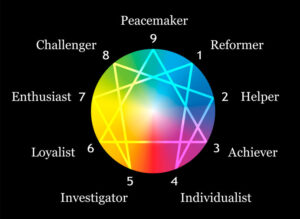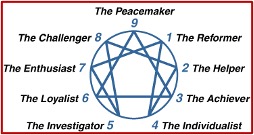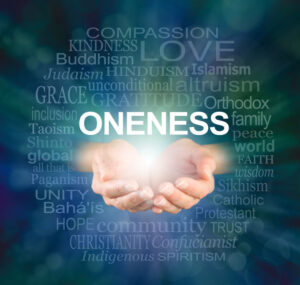Is the Enneagram Spiritually Neutral? Part 2
The Enneagram of personality was developed by two men, Oscar Ichazo and Claudio Naranjo. In “The Enneagram — A History (Part 3),” Brandon Medina said Ichazo and Naranjo each played a key role in reimagining the Enneagram. As a result, the modern Enneagram, the Enneagram of personality, is not being taught and practiced the way George Gurdjieff conceived it, “as a tool which can reveal all knowledge and by which the secrets of the cosmos are laid bare.” Medina suggested that you could say that the Enneagram created by Gurdjieff died with him.
In Part 1, we looked at some of the history behind the Enneagram, noting how Gurdjieff drew it from ancient sources, possibly from the Babylonians. The Law of Three and the Law of Seven in the Enneagram were noted to be the philosophical foundation of the Fourth Way, a method he developed for humans to switch from the temporal to the immortal—in order to experience the “real world.” Here, while looking at “The Enneagram—A History (Part 2),” we will see how the efforts of two men transformed the Enneagram into a mystical personality test.
Ichazo and His Scientific “Discovery”
Oscar Ichazo was born in Bolivia in 1931. At the age of nineteen he joined a study group that experimented with techniques of altered consciousness. “I had contact with Indians and they introduced me to psychedelic drugs and shamanism while I was in my early teens.” Roughly one year later he was introduced to the writings of both George Gurdjieff and P.D. Ouspensky, a student of Gurdjieff. Ichazo said in 1950 he was invited to a closed study group that included Theosophists, esoteric Rosicrucians, and a sect of mystical Christians called Martinists, where he took part in long discussions about the work of Gurdjieff and Ouspensky. “I first pointed out to this group that all the ideas proposed by Gurdjieff and Ouspensky could be traced to certain forms of Gnosticism and to specific doctrines of the Stoics, the Epicurians, and the Manichaeans.”
Ichazo began to research Eastern tantra and the Holy Kabbalah. He traveled to Tibet and India to study yoga, alchemy, I Ching Kabbalah, Buddhism, Zen and Sufism. “Ichazo claimed to have received insight and instruction from Metatron the prince of the archangels and students whom Ichazo trained at his Arica Institute were guided by their own spirit guide, the Green Qu ’Tab, once they reach a higher state of development.” After waking from “a divine coma” he was in for seven days, he realized he had been entrusted to bring a special new accelerated method of spiritual work to the West.
Most Enneagram practitioners attribute the nine personality categories and their corresponding numbers on the Enneagram figure to Ichazo. He said the Enneagram of personality came to him in a vision and was his sole invention. He also introduced several other Enneagrams, which he called enneagons, for a total of one hundred and eight. The only differences were the terms surrounding the Enneagram figure, not the figure itself. He claimed direct revelation of all 108 Enneagram types.
I never considered them my invention, but a discovery as scientific discoveries are, with exactly the same qualifications of being verifiable and objective. . . [They] reflect something real in human nature itself. We feel the categories have been discovered rather than invented.
He later modified this statement, saying he did not receive the enneagons from anyone. “They came to me, 108 in all, as in a vision, showing their internal relationships with complete clarity.” Ichazo said that not only was he the initiator of the Enneagram of personality, but also “the 108 enneagons and the entire system in all its terms have been developed by me, only and exclusively.” He began teaching a group of fifty-five students in Arica who sought to reach their human potential (striving to switch from the temporal to the immortal—in order to experience the “real world”) by listening to a series of his lectures and using a variety of spiritual practices based on mystical and meditative traditions.
Naranjo and What Came to Him
Claudio Naranjo was a Chliean psychiatrist born in 1932. He was also introduced to the Enneagram and Ouspensky in his teens. In 1962, Naranjo was at Harvard as a visiting Fulbright scholar, where he participated in Gordon Alport’s Social Psychology seminar. He became a close friend of Carlos Castaneda and was part of Leo Zeff’s psychedelic therapy group in 1965-66. While taking a pilgrimage after the death of his son, Naranjo returned to Chile and became a student of Ichazo’s at the Arica Institute.
Naranjo corroborated Ichazo’s claim about how he received the enneagons. He said it was his own reading of Ouspensky and the Fourth Way that led him to Ichazo. “My main interest in learning from Oscar Ichazo was a conviction that he was a link to the Sarmouni—the school behind Gurdjieff.” But like Ichazo, Naranjo muddied the water as to the origin of the Enneagram of personality, initially saying it was Ichazo who introduced him to the Enneagram during Ichazo’s series of lectures.
Later, he seemed to suggest Ichazo cared very little for the Enneagram. Referring to Ichazo, Naranjo said, “He didn’t talk about the enneagrams of personality more than two hours during our year with him.” Naranjo said if Ichazo was credited as the ‘seed’ of the enneagram movement, “I should rather compare myself to the gardener who has watered the plant.” He claimed it was he, Naranjo, who put into words what Ichazo had the barest understanding and description of. Naranjo has also stated the psychological types of the Enneagram came to him by a process of ‘automatic writing.’
Naranjo sites his ‘automatic’ writing while Ichazo has said that a person “may receive instructions from the higher entities such as Metatron, the prince of the archangels, who has given instructions to Ichazo.” It was the contradictory claims of origin between the two and specifically the supernatural claims of inspiration made by both men which would later become a problem regarding ownership for Ichazo, Naranjo, and Arica.
Naranjo brought the Enneagram of personality to the Esalen Institute in Big Sur, California. Esalen was an experimental center of esoteric ideas that had a crucial role in the human potential movement. Naranjo’s connection to Esalen was through his being an apprentice of Fritz Perls, and part of the early Gestalt Therapy movement, where he conducted workshops as a visiting associate at Esalen. One of Naranjo’s students at Esalen was a Jesuit priest, Bob Ochs, who took what he had learned about the Enneagram of personality to Loyola University in 1971.
The Enneagram Goes to Church
There Ochs taught the Enneagram of personality to several priests, including Don Riso, Mitch Pawca and Gerry Hare, who later taught it to Richard Rohr. In time, Don Riso left the priesthood and cofounded The Enneagram Institute with Russ Hudson. Pawca eventually abandoned the Enneagram, concerned it was introducing New Age beliefs into Catholicism. He wrote Catholics and the New Age in 1992 and “Enneagram: A Modern Myth.” Within the chapter, “Occult Roots of the Enneagram,” Pawca said:
The books by Gurdjieff’s disciples and articles about Oscar Ichazo prove they practiced occultism and that occultism is interwoven with the enneagram itself. Therefore, I believe Christians need to be aware of the enneagram’s occult origins so they can prevent occult traces from infecting their faith in Christ Jesus.
Lastly, there is Richard Rohr, who would become one of the key figures to popularize the Enneagram of personality within evangelical churches. He is a Franciscan priest who founded the Center for Action and Contemplation in Albuquerque, New Mexico. He’s published over thirty books, including: The Enneagram: A Christian Perspective and Discovering the Enneagram: An Ancient Tool a New Spiritual Journey. He wrote the Foreword to The Sacred Enneagram by Christopher Heuertz. Ian Cron and Susan Stabile, co-authors of The Road Back To You, along with Heuertz are friends and students of Rohr. The Sacred Enneagram and The Road Back to You are two of the most popular and widely read books on the Enneagram of personality within evangelical churches.
Medina noted how the competing claims of the supernatural origin of what they taught led to problems regarding ownership of the Enneagram of personality for Ichazo, Naranjo and Arica. The origins debate only became worse as students of both Ichazo and Naranjo disregarded non-disclosure agreements they signed and began to teach and write about what they had been taught. “In an attempt to stem the tide Naranjo went so far as to say that if these techniques were used or published outside of his training they would lessen in effect.” Yet, Naranjo failed to make those attending his public meetings sign a nondisclosure.
Much like what happened with Ichazo and Naranjo, attributions of conflicting origins were made by the various authors. Riso claimed a contemporary originship of Ichazo and Naranjo and not an ancient one as was claimed by Gurdjieff only to later change his position; Speeth and Palmer claimed an ancient origin which was developed by Gurdjieff and the Sufis. Though Palmer does agree with Ichazo’s claim that he developed a “new tradition” apart from the context [of] Sufi, Christian, and Gurdjieff into “an eclectic new age spiritual growth context.” No one can seem to agree if it is new or ancient, or new but ancient, or ancient but new. Because of the violation of the non-disclosure agreement as mentioned above, Arica would bring a lawsuit claiming copyright infringement; and in an ironic and amusing turn of events the very people whom broke the non-disclosure agreement they signed with Arica later made their students also sign non-disclosure agreements which they summarily ignored and broke. The books which quickly followed began to remove Arica, Ichazo, and Naranjo as originators of the Enneagram while some sought to ‘Christianize’ it.
There are now over 30 books by Christian publishers on the Enneagram of personality. IVP, InterVarsity Press, has books by Suzanne Stabile, Alice Fryling, Sean Palmer, and others. Zondervan publishes works by Christopher Heurtz. Thomas Nelson publishes Enneagram books by Beth McCord and Matthew Stephen Brown. There are dozens of Christian Enneagram coaches, like Beth McCord, the founder of YEC (Your Enneagram Coach), who provide “courses, coaching and community to help you discover your best self, using the tool of the Enneagram through the lens of the Gospel.”
Is the Enneagram of personality a ‘tool’ Christians can use? According to Beth McCord, you can see yourself “with astonishing clarity with the Enneagram through the lens of the Gospel, so [you] can break free from self-condemnation, fear, and shame by knowing and experiencing the unconditional love, forgiveness, and freedom in Christ.” We’ll examine this claim in the light of Scripture and look at a biblical critique of the Enneagram and the Enneagram of personality in Part 3 of this article.



